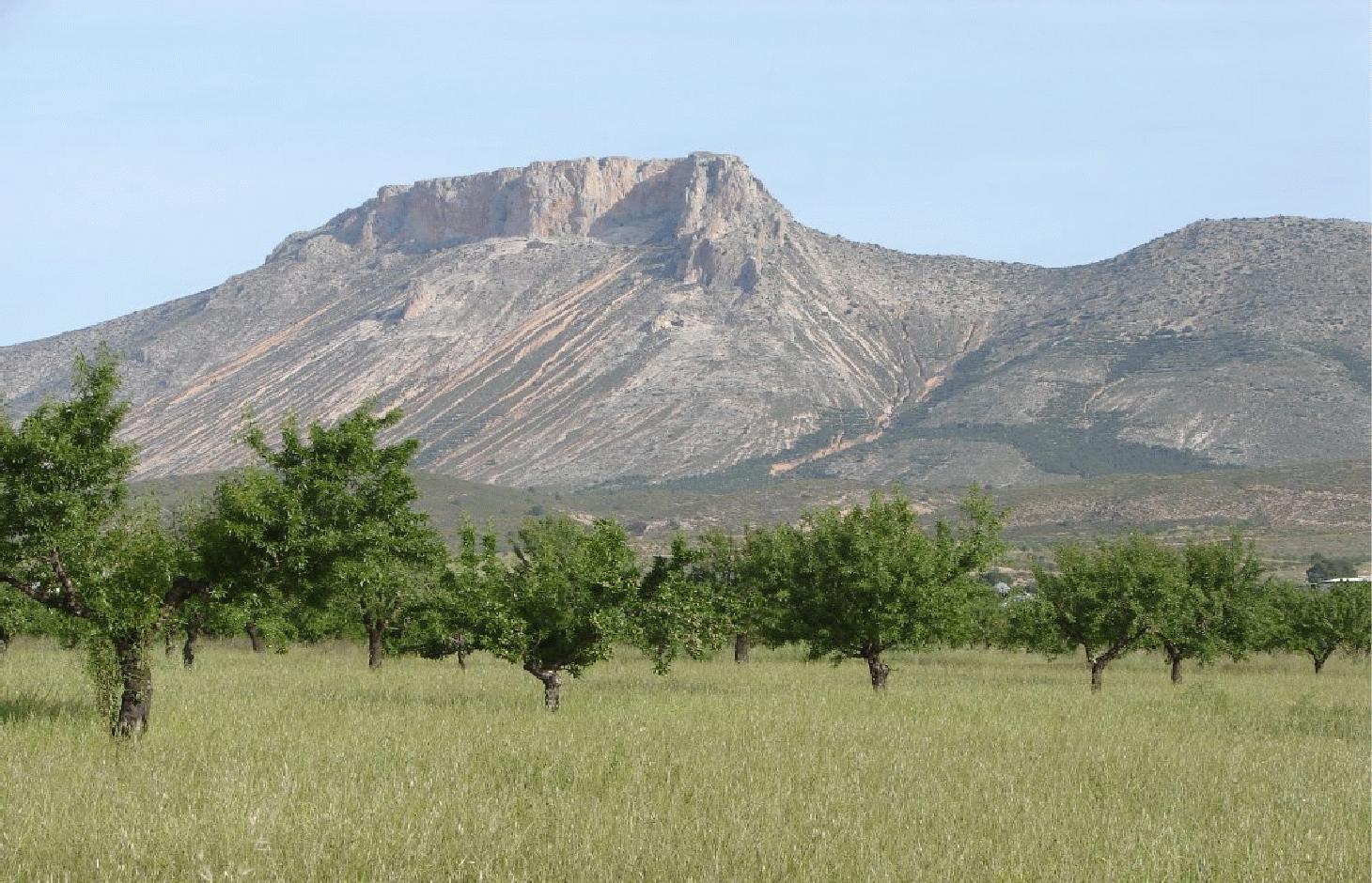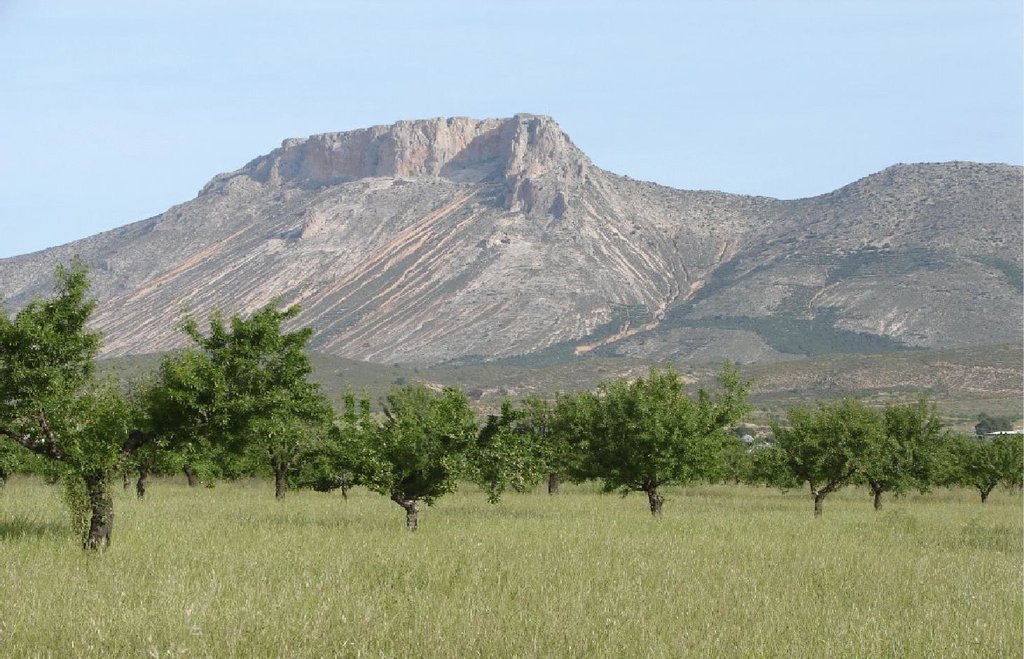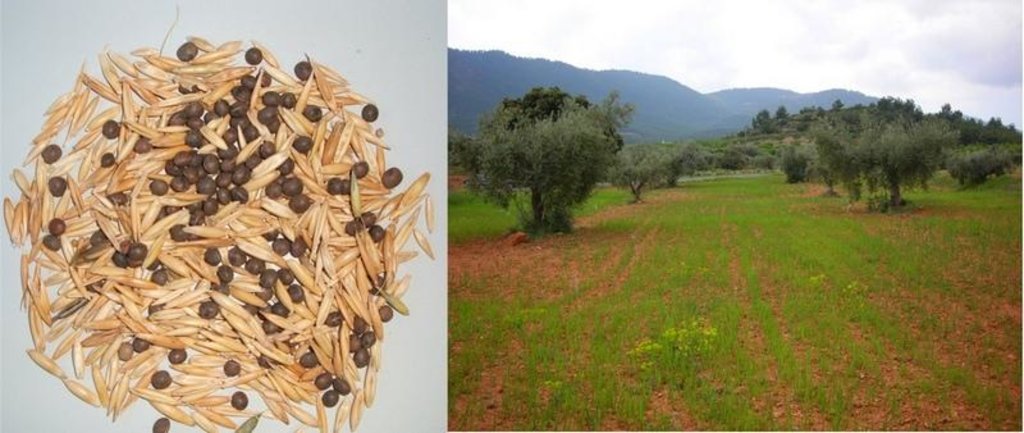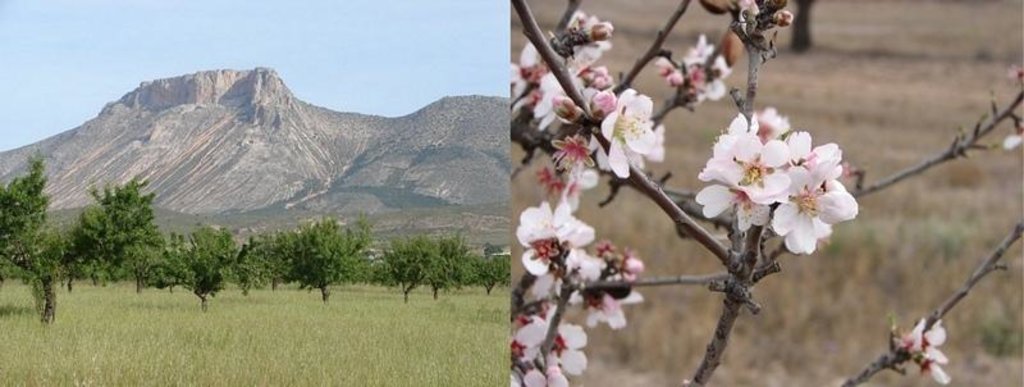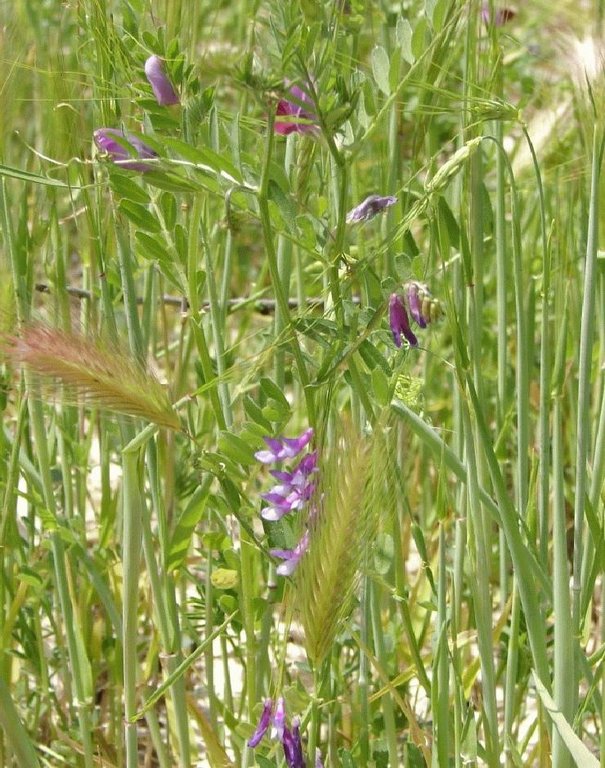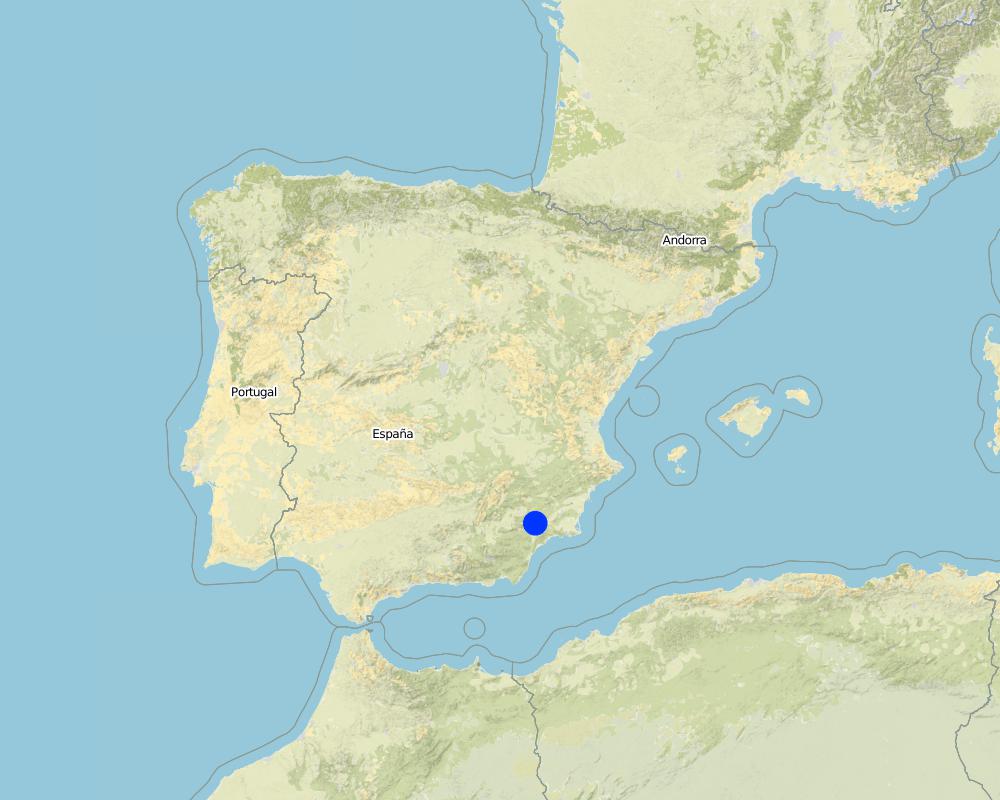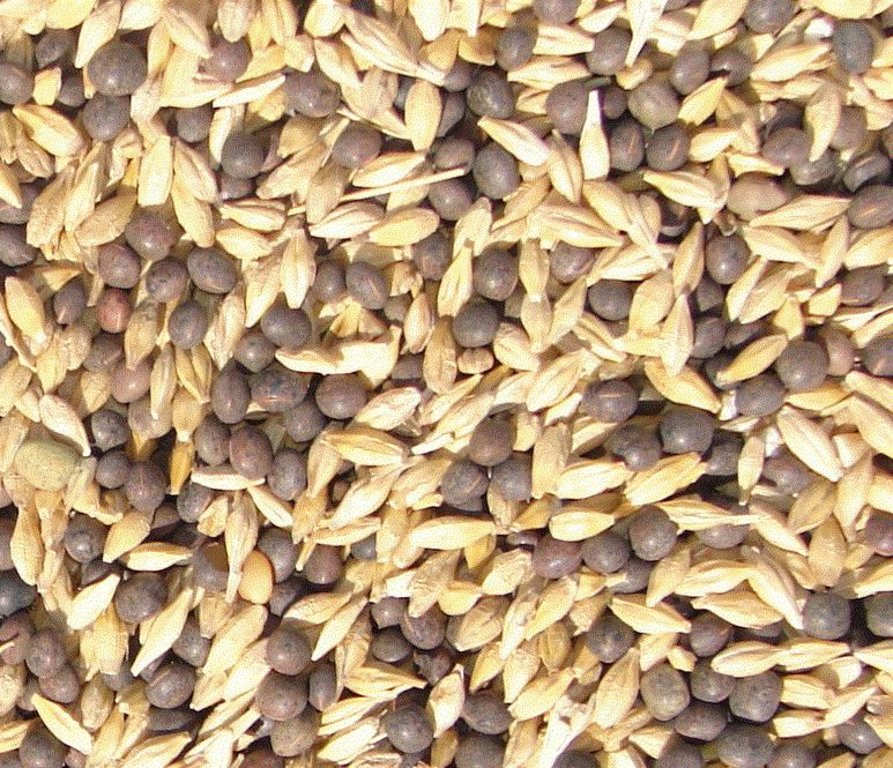Ecological production of almonds and olives using green manure [สเปน]
- ผู้สร้างสรรค์:
- การอัพเดท:
- ผู้รวบรวม: Joris De Vente
- ผู้เรียบเรียง: –
- ผู้ตรวจสอบ: Fabian Ottiger, Deborah Niggli, Alexandra Gavilano
Agricultura ecológica de almendros y olivos (Spanish)
technologies_1019 - สเปน
ดูส่วนย่อย
ขยายทั้งหมด ย่อทั้งหมด1. ข้อมูลทั่วไป
1.2 รายละเอียดที่ติดต่อได้ของผู้รวบรวมและองค์กรที่เกี่ยวข้องในการประเมินและการจัดเตรียมทำเอกสารของเทคโนโลยี
ผู้เชี่ยวชาญ SLM:
ผู้เชี่ยวชาญ SLM:
López Carratala Jorge
Consejo Superior de Investigaciones Científicas, Estación Experimental de Zonas Áridas (EEZA-CSIC)
สเปน
ผู้เชี่ยวชาญ SLM:
Ibáñez Torres Ascensión
Consejería de Agricultura y Agua Murcia (CARM)
สเปน
ผู้ใช้ที่ดิน:
Escamez Antonio
สเปน
Inspector for ecological agriculture :
López Ros Elias
สเปน
Responsible technician of ALIMER agricultural cooperation:
Lopez Pedro
ALIMER
สเปน
Technical agronomic engineer :
Cervantes Pujante Celestino
COATO S.Coop
สเปน
ผู้เชี่ยวชาญ SLM:
Martinez-Mena Maria
CEBAS-CSIC.
สเปน
ชื่อของโครงการซึ่งอำนวยความสะดวกในการทำเอกสารหรือการประเมินเทคโนโลยี (ถ้าเกี่ยวข้อง)
DESIRE (EU-DES!RE)ชื่อขององค์กรซึ่งอำนวยความสะดวกในการทำเอกสารหรือการประเมินเทคโนโลยี (ถ้าเกี่ยวข้อง)
EEZA-CSIC (EEZA-CSIC) - สเปนชื่อขององค์กรซึ่งอำนวยความสะดวกในการทำเอกสารหรือการประเมินเทคโนโลยี (ถ้าเกี่ยวข้อง)
Consejería de Agricultura y Agua Murcia (CARM) - สเปนชื่อขององค์กรซึ่งอำนวยความสะดวกในการทำเอกสารหรือการประเมินเทคโนโลยี (ถ้าเกี่ยวข้อง)
Alimentos del mediterráneo (ALIMER) - สเปนชื่อขององค์กรซึ่งอำนวยความสะดวกในการทำเอกสารหรือการประเมินเทคโนโลยี (ถ้าเกี่ยวข้อง)
COATO - สเปนชื่อขององค์กรซึ่งอำนวยความสะดวกในการทำเอกสารหรือการประเมินเทคโนโลยี (ถ้าเกี่ยวข้อง)
Centro de Edafología y Biología Aplicada del Segura (CEBAC-CSIC) - สเปน1.3 เงื่อนไขการใช้ข้อมูลที่ได้บันทึกผ่านทาง WOCAT
ผู้รวบรวมและวิทยากรหลักยอมรับเงื่อนไขเกี่ยวกับการใช้ข้อมูลที่ถูกบันทึกผ่านทาง WOCAT:
ใช่
1.5 Reference to Questionnaire(s) on SLM Approaches (documented using WOCAT)
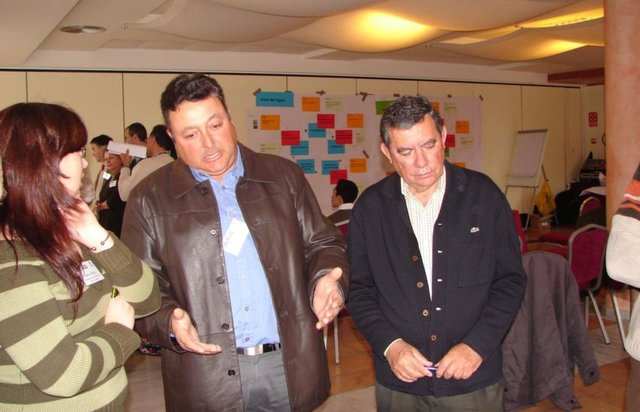
Regional rural development programme [สเปน]
Regional development programme to protect natural resources and stimulate rural economies.
- ผู้รวบรวม: Joris De Vente
2. การอธิบายลักษณะของเทคโนโลยี SLM
2.1 การอธิบายแบบสั้น ๆ ของเทคโนโลยี
คำจำกัดความของเทคโนโลยี:
Ecological production of almonds and olives under dryland conditions using green manure to increase soil fertility, to protect against soil erosion and to obtain a high-value product.
2.2 การอธิบายแบบละเอียดของเทคโนโลยี
คำอธิบาย:
Ecological agriculture is a strictly controlled production system that does not use synthetic chemical products like fertilizers, insecticides or pesticides. Also genetically modified organisms and materials are not used. Green manure or low quantities of organic fertilizers, preferably from dung (sheep, goat, cow, chicken), are used to increase and maintain soil fertility. Green manure is provided by seeding a mixture of leguminous nitrogen-fixing species and cereals in autumn (October) and incorporating this into the soil with tillage in springtime (May). To optimize the fertilizer effect, there is still scientific discussion on the need for mowing the green manure and letting it dry for several days before it is ploughed into the soil. For this system, no ploughing is performed in winter, which reduces fuel use and emission of greenhouse gases. In addition to its fertilising effect, green manure provides a continuous surface cover during winter time protecting the soil from erosion. The products grown under this ecological system command a higher market price than those grown under conventional production schemes.
Purpose of the Technology: The aim of ecological agriculture is to protect biodiversity and the environment and maintain or improve soil fertility and reduce soil, water, and air pollution. Under ecological agriculture and by using green manure, soil cover, soil organic matter, and soil biological activity will increase, which positively affects soil structure, soil fertility and soil water infiltration capacity. This reduces the sensitivity of the soil to surface crusting and it reduces surface runoff and soil erosion by up to 60%. Workload and energy use are up to 50% lower than under conventional agriculture, and benefits may increase around 40% due to higher yields. Moreover, a higher market price of ecologically produced almonds and olives will lead to increased farm income. This better economic return discourages land abandonment of marginal lands with low productivities under conventional farming. Ecological almonds and olives production does not require special establishment activities or investments in specialized equipment.
Establishment / maintenance activities and inputs: Infestations by, for example, insects and caterpillars are treated twice yearly by degradable products based on copper salts (Oxicloruro, max 3‰ solution) and mineral oils in winter, or the spores and proteins produced by the bacteria Bacillus thuringiensis or based on natural pyrethrins (from the Chrysanthemum cinerariaefolium; max 1.5 l/ha) in springtime. In ecological agriculture, farmers are obliged to take advice and instructions regarding plague control and fertilizer use from technicians specialized in ecological agriculture.
Natural / human environment: Soils mostly have a shallow to medium depth (between 20-60 cm), and slopes are gentle to moderate (between 5 and 15%). The climate is semi-arid with a mean annual rainfall around 300 mm. Droughts, in summer, commonly last for more than 4-5 months. Annual potential evapotranspiration rates larger than 1000 mm are common. The production system is highly mechanised and market-oriented but depends strongly on agricultural subsidies. All cropland is privately owned.
2.3 รูปภาพของเทคโนโลยี
2.5 ประเทศภูมิภาค หรือสถานที่ตั้งที่เทคโนโลยีได้นำไปใช้และได้รับการครอบคลุมโดยการประเมินนี้
ประเทศ:
สเปน
ภูมิภาค/รัฐ/จังหวัด:
Murcia
ข้อมูลจำเพาะเพิ่มเติมของสถานที่ตั้ง :
Guadalentin catchment
ระบุการกระจายตัวของเทคโนโลยี:
- กระจายไปอย่างสม่ำเสมอในพื้นที่
If precise area is not known, indicate approximate area covered:
- 10-100 ตร.กม.
Map
×2.6 วันที่การดำเนินการ
ถ้าไม่รู้ปีที่แน่นอน ให้ระบุวันที่โดยประมาณ:
- น้อยกว่า 10 ปี (ไม่นานนี้)
2.7 คำแนะนำของเทคโนโลยี
ให้ระบุว่าเทคโนโลยีถูกแนะนำเข้ามาอย่างไร:
- ทางโครงการหรือจากภายนอก
ความคิดเห็น (ประเภทของโครงการ เป็นต้น) :
Ecological agriculture is strongly stimulated by regional government through subsidies in last 8 years.
3. การจัดประเภทของเทคโนโลยี SLM
3.2 ประเภทของการใช้ที่ดินในปัจจุบันที่ได้นำเทคโนโลยีไปใช้

พื้นที่ปลูกพืช
- การปลูกไม้ยืนต้น ไม้พุ่ม
จำนวนของฤดูเพาะปลูกต่อปี:
- 1
ระบุ:
Longest growing period in days: 220Longest growing period from month to month: Nov - Jun
แสดงความคิดเห็น:
Major land use problems (compiler’s opinion): A lack of water availability seriously limits the production potential of the soil and results in a low vegetation/crop cover. The relatively high soil erosion rates cause various off-site related problems (i.e. flooding, reservoir siltation) and on-site problems (i.e. gully formation and reduced soil depth).
Major land use problems (land users’ perception): There is a lack of water for irrigation of crops limiting the crop types that can be planted as well as the crop yield of dryland farming.
Livestock is grazing on crop residues
3.4 การใช้น้ำ
การใช้น้ำของที่ดินที่มีการใช้เทคโนโลยีอยู่:
- จากน้ำฝน
3.5 กลุ่ม SLM ที่ตรงกับเทคโนโลยีนี้
- การจัดการความอุดมสมบรูณ์ของดินแบบผสมผสาน
3.6 มาตรการ SLM ที่ประกอบกันเป็นเทคโนโลยี

มาตรการจัดการพืช
- A2: อินทรียวัตถุในดิน/ความอุดมสมบูรณ์ในดิน

มาตรการอนุรักษ์ด้วยการจัดการ
- M6: การจัดการของเสีย (การทำ รีไซเคิล การเอากลับมาใช้ใหม่หรือการลดปริมาณ)
แสดงความคิดเห็น:
Main measures: agronomic measures
Secondary measures: management measures
Type of agronomic measures: green manure
3.7 รูปแบบหลักของการเสื่อมโทรมของที่ดินที่ได้รับการแก้ไขโดยเทคโนโลยี

การกัดกร่อนของดินโดยน้ำ
- Wt (Loss of topsoil): การสูญเสียดินชั้นบนหรือการกัดกร่อนที่ผิวดิน
- Wo (Offsite degradation): ผลกระทบนอกพื้นที่

การเสื่อมโทรมของดินทางด้านเคมี
- Cn (Fertility decline): ความอุดมสมบูรณ์และปริมาณอินทรียวัตถุในดินถูกทำให้ลดลงไป (ไม่ได้เกิดจากสาเหตุการกัดกร่อน)
- Cp (Soil pollution): มลพิษในดิน

การเสื่อมโทรมของดินทางด้านชีวภาพ
- Bl (Loss of soil life): การสูญเสียสิ่งมีชีวิตในดิน
- Bp (Increase of pests/diseases): การเพิ่มขึ้นของศัตรูพืชและโรคพืช

การเสื่อมโทรมของน้ำ
- Hp (Decline of surface water quality): การลดลงของคุณภาพน้ำที่ผิวดิน
- Hq (Decline of groundwater quality): การลดลงของคุณภาพน้ำบาดาล
แสดงความคิดเห็น:
Main type of degradation addressed: Wo: offsite degradation effects, Cp: soil pollution, Hq: decline of groundwater quality
Secondary types of degradation addressed: Wt: loss of topsoil / surface erosion, Cn: fertility decline and reduced organic matter content, Bl: loss of soil life, Bp: increase of pests / diseases, loss of predators, Hp: decline of surface water quality
Main causes of degradation: soil management (Excessive use of pesticides and herbicides), crop management (annual, perennial, tree/shrub) (Excessive use of pesticides and herbicides), education, access to knowledge and support services (lack of knowledge of off site effects for contamination)
3.8 การป้องกัน การลดลง หรือการฟื้นฟูความเสื่อมโทรมของที่ดิน
ระบุเป้าหมายของเทคโนโลยีกับความเสื่อมโทรมของที่ดิน:
- ป้องกันความเสื่อมโทรมของที่ดิน
- ลดความเสื่อมโทรมของดิน
แสดงความคิดเห็น:
Main goals: prevention of land degradation, mitigation / reduction of land degradation
4. ข้อมูลจำเพาะด้านเทคนิค กิจกรรมการนำไปปฏิบัติใช้ ปัจจัยนำเข้า และค่าใช้จ่าย
4.1 แบบแปลนทางเทคนิคของเทคโนโลยี
ข้อมูลจำเพาะด้านเทคนิค (แบบแปลนทางเทคนิคของเทคโนโลยี):
Mixture of barley and vetch (Vicia sativa) seeds used for seeding green manure.
Technical knowledge required for field staff / advisors: high (High level of knowledge of possibilities and limitations of fertilizer use and plague control is needed.)
Technical knowledge required for land users: moderate (Moderate level of knowledge of fertilizer use and plague control.)
Main technical functions: control of dispersed runoff: retain / trap, control of dispersed runoff: impede / retard, improvement of ground cover, increase in nutrient availability (supply, recycling,…)
Secondary technical functions: improvement of surface structure (crusting, sealing), improvement of topsoil structure (compaction), improvement of subsoil structure (hardpan), increase in organic matter, increase of infiltration, increase / maintain water stored in soil, improvement of water quality, buffering / filtering water
Green manure
Material/ species: seed
Quantity/ density: 195 kg/ha
Remarks: Mixture of Vicia (65kg) and Avena (130kg)
Other type of management: Ecological farming: Absence of chemical fertilizers, pesticides and herbicides
ผู้เขียน:
Joris de Vente
4.2 ข้อมูลทั่วไปเกี่ยวกับการคำนวณปัจจัยนำเข้าและค่าใช้จ่าย
อื่นๆ หรือสกุลเงินประจำชาติ (ระบุ):
EURO
If relevant, indicate exchange rate from USD to local currency (e.g. 1 USD = 79.9 Brazilian Real): 1 USD =:
0.63
ระบุค่าเฉลี่ยของค่าจ้างในการจ้างแรงงานต่อวัน:
79.00
4.4 ค่าใช้จ่ายของปัจจัยนำเข้าที่จำเป็นสำหรับการจัดตั้ง
แสดงความคิดเห็น:
Duration of establishment phase: 1 month(s)
4.5 การบำรุงรักษาสภาพหรือกิจกรรมที่เกิดขึ้นเป็นประจำ
| กิจกรรม | ช่วงระยะเวลา/ความถี่ | |
|---|---|---|
| 1. | seeding green manure | autumn (October) |
| 2. | ploughing green manure | spring (May) |
| 3. | organic fertilizer of cow dung (optional) | spring |
| 4. | ecological treatment against plagues days | winter and april |
4.6 ค่าใช้จ่ายของปัจจัยนำเข้าและกิจกรรมที่เกิดขึ้นเป็นประจำที่ต้องการการบำรุงรักษา (ต่อปี)
| ปัจจัยนำเข้า | หน่วย | ปริมาณ | ค่าใช้จ่ายต่อหน่วย | ค่าใช้จ่ายทั้งหมดต่อปัจจัยนำเข้า | %ของค่าใช้จ่ายที่ก่อให้เกิดขึ้นโดยผู้ใช้ที่ดิน | |
|---|---|---|---|---|---|---|
| แรงงาน | Labour | ha | 1.0 | 25.0 | 25.0 | 37.0 |
| อุปกรณ์ | Machine use | ha | 1.0 | 72.0 | 72.0 | 37.0 |
| วัสดุด้านพืช | Seeds | ha | 1.0 | 96.0 | 96.0 | 37.0 |
| ปุ๋ยและสารฆ่า/ยับยั้งการเจริญเติบโตของสิ่งมีชีวิต (ไบโอไซด์) | Fertilizer | ha | 1.0 | 79.0 | 79.0 | 37.0 |
| ปุ๋ยและสารฆ่า/ยับยั้งการเจริญเติบโตของสิ่งมีชีวิต (ไบโอไซด์) | Biocides | ha | 1.0 | 159.0 | 159.0 | 37.0 |
| ค่าใช้จ่ายทั้งหมดของการบำรุงรักษาสภาพเทคโนโลยี | 431.0 | |||||
| Total costs for maintenance of the Technology in USD | 684.13 | |||||
แสดงความคิดเห็น:
Machinery/ tools: tractor with seeding machinery, tractor
Cow dung costs approximately US $350 per tonne and will therefore increase the costs significantly if applied. The costs are calculated assuming the application of green manure, ecological pesticides and organic fertilizer. However, many farmers decide not to use organic fertilizer because of their high costs. As part of the Rural Development Programme (QASPA01), ecological agriculture receives a subsidy of 476 US $ per ha during the first 3 years of production, after which the subsidy is reduced to 380 US $ per ha. Prices are for spring 2008.
4.7 ปัจจัยสำคัญที่สุดที่มีผลกระทบต่อค่าใช้จ่าย
ปัจจัยสำคัญที่สุดที่มีผลกระทบต่อค่าใช้จ่ายต่างๆ:
Fuel price, ecological pesticides and organic fertilizer are the most determining factors affecting the costs.
5. สิ่งแวดล้อมทางธรรมชาติและของมนุษย์
5.1 ภูมิอากาศ
ฝนประจำปี
- < 250 ม.ม.
- 251-500 ม.ม.
- 501-750 ม.ม.
- 751-1,000 ม.ม.
- 1,001-1,500 ม.ม.
- 1,501-2,000 ม.ม.
- 2,001-3,000 ม.ม.
- 3,001-4,000 ม.ม.
- > 4,000 ม.ม.
ข้อมูลจำเพาะ/ความคิดเห็นเรื่องปริมาณน้ำฝน:
Dry period in summer during 3-4 months (June – August/September)
เขตภูมิอากาศเกษตร
- กึ่งแห้งแล้ง
Thermal climate class: subtropics
Thermal climate class: temperate. The higher parts are generally somewhat colder
5.2 สภาพภูมิประเทศ
ค่าเฉลี่ยความลาดชัน:
- ราบเรียบ (0-2%)
- ลาดที่ไม่ชัน (3-5%)
- ปานกลาง (6-10%)
- เป็นลูกคลื่น (11-15%)
- เป็นเนิน (16-30%)
- ชัน (31-60%)
- ชันมาก (>60%)
ธรณีสัณฐาน:
- ที่ราบสูง/ที่ราบ
- สันเขา
- ไหล่เขา
- ไหล่เนินเขา
- ตีนเนิน
- หุบเขา
ระดับความสูง:
- 0-100 เมตร
- 101-500 เมตร
- 501-1,000 เมตร
- 1,001-1,500 เมตร
- 1,501-2,000 เมตร
- 2,001-2,500 เมตร
- 2,501-3,000 เมตร
- 3,001-4,000 เมตร
- > 4,000 เมตร
ให้ระบุถ้าเทคโนโลยีได้ถูกนำไปใช้:
- ไม่เกี่ยวข้อง
ความคิดเห็นและข้อมูลจำเพาะเพิ่มเติมเรื่องสภาพภูมิประเทศ:
Landforms: plateau / plains, hill slopes, footslopes, valley floors
5.3 ดิน
ค่าเฉลี่ยความลึกของดิน:
- ตื้นมาก (0-20 ซ.ม.)
- ตื้น (21-50 ซ.ม.)
- ลึกปานกลาง (51-80 ซ.ม.)
- ลึก (81-120 ซ.ม.)
- ลึกมาก (>120 ซ.ม.)
เนื้อดิน (ดินชั้นบน):
- ปานกลาง (ดินร่วน ทรายแป้ง)
- ละเอียด/หนัก (ดินเหนียว)
อินทรียวัตถุในดิน:
- ปานกลาง (1-3%)
- ต่ำ (<1%)
(ถ้ามี) ให้แนบคำอธิบายเรื่องดินแบบเต็มหรือระบุข้อมูลที่มีอยู่ เช่น ชนิดของดิน ค่า pH ของดินหรือความเป็นกรดของดิน ความสามารถในการแลกเปลี่ยนประจุบวก ไนโตรเจน ความเค็ม เป็นต้น:
Soil fertility is low
Soil drainage/infiltration is poor/none
Soil water storage capacity is medium
5.4 ความเป็นประโยชน์และคุณภาพของน้ำ
ระดับน้ำใต้ดิน:
5-50 เมตร
น้ำไหลบ่าที่ผิวดิน:
ไม่ดีหรือไม่มีเลย
คุณภาพน้ำ (ที่ยังไม่ได้บำบัด):
เป็นน้ำใช้เพื่อการเกษตรเท่านั้น (การชลประทาน)
ความคิดเห็นและข้อมูลจำเพาะเพิ่มเติมเรื่องคุณภาพและปริมาณน้ำ:
Ground water table: >50m (there is a lowering of groundwater table due to overexploitation for irrigation purposes)
Availability of surface water:S Poor/none. Sporadically there are flash floods during extreme rainfall events
Water quality (untreated): For agricultural use only (irrigation) (groundwater from aquifers)
5.5 ความหลากหลายทางชีวภาพ
ความหลากหลายทางชนิดพันธุ์:
- ต่ำ
5.6 ลักษณะของผู้ใช้ที่ดินที่นำเทคโนโลยีไปปฏิบัติใช้
แนวทางการตลาดของระบบการผลิต:
- mixed (subsistence/ commercial)
- ทำการค้า/การตลาด
รายได้ที่มาจากนอกฟาร์ม:
- > 50% ของรายได้ทั้งหมด
ระดับของความมั่งคั่งโดยเปรียบเทียบ:
- พอมีพอกิน
เป็นรายบุคคล/ครัวเรือน:
- สหกรณ์
ระดับของการใช้เครื่องจักรกล:
- การใช้เครื่องจักรหรือเครื่องยนต์
เพศ:
- ชาย
ระบุลักษณะอื่นๆที่เกี่ยวข้องของผู้ใช้ที่ดิน:
Land users applying the Technology are mainly common / average land users
Difference in the involvement of women and men: Traditionally most agriculture is done by men in this region.
Population density: 10-50 persons/km2
Annual population growth: 3% - 4%
15% of the land users are rich and own 20% of the land.
80% of the land users are average wealthy and own 75% of the land.
5% of the land users are poor and own 5% of the land.
Off-farm income specification: There is no difference in the ones who apply the technology and those who don’t. Most farmers do have an off-farm income for example from hunting, work in a factory, office or from animal farming (pigs, rabbits).
Market orienation: Commercial/market and mixed (subsistence and commercial) (some farmers are weekend or hobby farmers and not market oriented)
5.7 Average area of land used by land users applying the Technology
- < 0.5 เฮกตาร์
- 0.5-1 เฮกตาร์
- 1-2 เฮกตาร์
- 2-5 เฮกตาร์
- 5-15 เฮกตาร์
- 15-50 เฮกตาร์
- 50-100 เฮกตาร์
- 100-500 เฮกตาร์
- 500-1,000 เฮกตาร์
- 1,000-10,000 เฮกตาร์
- >10,000 เฮกตาร์
พิจารณาว่าเป็นขนาดเล็ก กลาง หรือขนาดใหญ่ (ซึ่งอ้างอิงถึงบริบทระดับท้องถิ่น):
- ขนาดเล็ก
แสดงความคิดเห็น:
There are few farmers with large properties within the study area (100-500ha)
5.8 กรรมสิทธิ์ในที่ดิน สิทธิในการใช้ที่ดินและสิทธิในการใช้น้ำ
กรรมสิทธิ์ในที่ดิน:
- รายบุคคล ได้รับสิทธิครอบครอง
สิทธิในการใช้ที่ดิน:
- รายบุคคล
สิทธิในการใช้น้ำ:
- รายบุคคล
แสดงความคิดเห็น:
All cropland is privately owned. Water use is organised by permits to water extraction from aquifers on individual basis. Water rights are provided and controlled by the Water authority of the segura river basin (CHS).
5.9 การเข้าถึงบริการและโครงสร้างพื้นฐาน
การศึกษา:
- จน
- ปานกลาง
- ดี
ความช่วยเหลือทางด้านเทคนิค:
- จน
- ปานกลาง
- ดี
การจ้างงาน (เช่น ภายนอกฟาร์ม):
- จน
- ปานกลาง
- ดี
ตลาด:
- จน
- ปานกลาง
- ดี
พลังงาน:
- จน
- ปานกลาง
- ดี
ถนนและการขนส่ง:
- จน
- ปานกลาง
- ดี
น้ำดื่มและการสุขาภิบาล:
- จน
- ปานกลาง
- ดี
บริการด้านการเงิน:
- จน
- ปานกลาง
- ดี
6. ผลกระทบและสรุปคำบอกกล่าว
6.1 ผลกระทบในพื้นที่ดำเนินการ (On-site) จากการใช้เทคโนโลยี
ผลกระทบทางด้านเศรษฐกิจและสังคม
การผลิต
การผลิตพืชผล
รายได้และค่าใช้จ่าย
ค่าใช่จ่ายของปัจจัยการผลิตทางการเกษตร
แสดงความคิดเห็น/ระบุ:
Less fuel use for ploughing but plague control and cow dung can be costly during first years, but after 2-3 years costs are generally lower than under conventional farming because less pesticides are needed. Also use of organic fertilizer is expensive and requires subsidies
รายได้จากฟาร์ม
แสดงความคิดเห็น/ระบุ:
Depends on crop yield and market price.
ภาระงาน
ผลกระทบด้านสังคมวัฒนธรรมอื่น ๆ
สถานการณ์ด้านสุขภาพ
โอกาสทางวัฒนธรรม
แสดงความคิดเห็น/ระบุ:
Often farmers feel proud and satisfied of producing in a manner respectfull with the environment.
โอกาสทางด้านสันทนาการ
แสดงความคิดเห็น/ระบุ:
There is an added value of ecological agriculture for rural tourism activities
SLM หรือความรู้เรื่องความเสื่อมโทรมของที่ดิน
Improved livelihoods and human well-being
แสดงความคิดเห็น/ระบุ:
Farm income of most ecological farmers has increased due to higher market price, higher yield and subsidies
ผลกระทบด้านนิเวศวิทยา
วัฐจักรน้ำหรือน้ำบ่า
น้ำไหลบ่าที่ผิวดิน
ดิน
สิ่งปกคลุมดิน
แสดงความคิดเห็น/ระบุ:
Only with green manure
การสูญเสียดิน
การเกิดแผ่นแข็งที่ผิวดิน /การเกิดชั้นดาน
แสดงความคิดเห็น/ระบุ:
Less tractor use
การหมุนเวียนและการเติมของธาตุอาหาร
แสดงความคิดเห็น/ระบุ:
Due to more biological activity
อินทรียวัตถุในดิน/ต่ำกว่าดินชั้น C
ความหลากหลายทางชีวภาพของพืชและสัตว์
ความหลากหลายทางชีวภาพของพืช
ความหลากหลายทางชีวภาพของสัตว์
ชนิดพันธุ์ที่ให้ประโยชน์
การจัดการศัตรูพืชและโรคพืช
ลดความเสี่ยงของภัยพิบัติ
การปล่อยคาร์บอนและก๊าซเรือนกระจก
แสดงความคิดเห็น/ระบุ:
The production process of conventional synthetic fertilizerss and pesticides is an important source of greenhouse gasses. There is also less tractor use.
ผลกระทบด้านนิเวศวิทยาอื่น ๆ
Carbon sequestration
แสดงความคิดเห็น/ระบุ:
Under ecological agriculture more carbon is sequestred in the soil than under conventional farming
increased competition (water, sunlight, nutrients)
แสดงความคิดเห็น/ระบุ:
Green manure potentially leads to competition for water. Therefore it is crucial to plough before competition become simportant in springtime.
6.2 ผลกระทบนอกพื้นที่ดำเนินการ (Off-site) จากการใช้เทคโนโลยี
การทับถมของดินตะกอนพื้นที่ท้ายน้ำ
การเกิดมลพิษในน้ำบาดาลหรือแม่น้ำ
ความเสียหายต่อพื้นที่เพาะปลูกของเพื่อนบ้าน
6.3 การเผชิญและความตอบสนองของเทคโนโลยีต่อการเปลี่ยนแปลงสภาพภูมิอากาศที่ค่อยเป็นค่อยไป และสภาพรุนแรงของภูมิอากาศ / ภัยพิบัติ (ที่รับรู้ได้โดยผู้ใช้ที่ดิน)
การเปลี่ยนแปลงสภาพภูมิอากาศที่ค่อยเป็นค่อยไป
การเปลี่ยนแปลงสภาพภูมิอากาศที่ค่อยเป็นค่อยไป
| ฤดู | increase or decrease | เทคโนโลยีมีวิธีการรับมืออย่างไร | |
|---|---|---|---|
| อุณหภูมิประจำปี | เพิ่มขึ้น | ดี |
สภาพรุนแรงของภูมิอากาศ (ภัยพิบัติ)
ภัยพิบัติทางอุตุนิยมวิทยา
| เทคโนโลยีมีวิธีการรับมืออย่างไร | |
|---|---|
| พายุฝนประจำท้องถิ่น | ดี |
| พายุลมประจำท้องถิ่น | ดี |
ภัยพิบัติจากสภาพภูมิอากาศ
| เทคโนโลยีมีวิธีการรับมืออย่างไร | |
|---|---|
| ภัยจากฝนแล้ง | ไม่ค่อยดี |
ภัยพิบัติจากน้ำ
| เทคโนโลยีมีวิธีการรับมืออย่างไร | |
|---|---|
| น้ำท่วมตามปกติ (แม่น้ำ) | ดี |
ผลลัพธ์ตามมาที่เกี่ยวข้องกับภูมิอากาศอื่น ๆ
ผลลัพธ์ตามมาที่เกี่ยวข้องกับภูมิอากาศอื่น ๆ
| เทคโนโลยีมีวิธีการรับมืออย่างไร | |
|---|---|
| ช่วงการปลูกพืชที่ลดลงมา | ดี |
แสดงความคิดเห็น:
The crop type is sensitive to changes in water availability under the semi arid conditions.
6.4 การวิเคราะห์ค่าใช้จ่ายและผลประโยชน์ที่ได้รับ
ผลประโยชน์ที่ได้รับเปรียบเทียบกับค่าใช้จ่ายในการจัดตั้งเป็นอย่างไร (จากมุมมองของผู้ใช้ที่ดิน)
ผลตอบแทนระยะสั้น:
เป็นกลางหรือสมดุล
ผลตอบแทนระยะยาว:
เป็นกลางหรือสมดุล
ผลประโยชน์ที่ได้รับเปรียบเทียบกับค่าใช้จ่ายในการบำรุงรักษาหรือต้นทุนที่เกิดขึ้นซ้ำอีก เป็นอย่างไร (จากมุมมองของผู้ใช้ที่ดิน)
ผลตอบแทนระยะสั้น:
ด้านลบเล็กน้อย
ผลตอบแทนระยะยาว:
ด้านบวกเล็กน้อย
แสดงความคิดเห็น:
First years require some adaptation, but after 1-2 years the higher market price and crop yield will generate a slightly higher income.
6.5 การปรับตัวของเทคโนโลยี
Of all those who have adopted the Technology, how many did so spontaneously, i.e. without receiving any material incentives/ payments?
- 0-10%
แสดงความคิดเห็น:
95% of land user families have adopted the Technology with external material support
Comments on acceptance with external material support: The majority is convinced by the subsidies provided for ecological agriculture
5% of land user families have adopted the Technology without any external material support
Comments on spontaneous adoption: There is a limited number of farmers that started already before the existence of subsidies.
There is a moderate trend towards spontaneous adoption of the Technology
Comments on adoption trend: Spontaneous, but strongly driven by available subsidies.
6.7 จุดแข็ง / ข้อได้เปรียบ / โอกาสของเทคโนโลยี
| จุดแข็ง / ข้อได้เปรียบ / โอกาสในทัศนคติของผู้ใช้ที่ดิน |
|---|
|
High quality products with a good market price are produced How can they be sustained / enhanced? Costs of pest control should fall |
| จุดแข็ง / ข้อได้เปรียบ / โอกาสในทัศนคติของผู้รวบรวมหรือวิทยากรหลัก |
|---|
|
Ecological agriculture and green manure have a very positive effect on soil quality, biodiversity and reduction of runoff and erosion How can they be sustained / enhanced? Reduced costs related to pest control |
|
High quality products of ecological agriculture provide a good impression and an attractive product How can they be sustained / enhanced? Better marketing of eco-almond and olives |
6.8 จุดอ่อน / ข้อเสียเปรียบ / ความเสี่ยงของเทคโนโลยีและวิธีการแก้ไข
| จุดอ่อน / ข้อเสียเปรียบ / ความเสี่ยงในทัศนคติของผู้ใช้ที่ดิน | มีวิธีการแก้ไขได้อย่างไร |
|---|---|
| Application of green manure is competition for water for the crop. | Plough away the green cover on time in spring before competition becomes important. Moreover, provide demonstrations on the effects of green manure on competition and crop productivity by additional nitrogen input. |
| จุดอ่อน / ข้อเสียเปรียบ / ความเสี่ยงในทัศนคติของผู้รวบรวมหรือวิทยากรหลัก | มีวิธีการแก้ไขได้อย่างไร |
|---|---|
| Application of organic fertilizers and ecological pest control is relatively expensive and depend on subsidies especially in the first few years of implementation | Look for cheaper methods and combine possibly with other techniques such as reduced tillage to further reduce the costs. After several years, normally less pest control is required due to increased natural control and ecosystem integrity. |
7. การอ้างอิงและการเชื่อมต่อ
7.1 วิธีการและแหล่งข้อมูล
7.3 Links to relevant online information
ชื่อเรื่องหรือคำอธิบาย:
Online shop for fertilizers and pesticides allowed in ecological agriculture.
URL:
http://www.ecotenda.net/info/
ชื่อเรื่องหรือคำอธิบาย:
Centro de Formación de la Asociación CAAE 2006 El cultivo del almendro en producción ecológica 15pp.
URL:
http://www.juntadeandalucia.es/agriculturaypesca/portal/www/portal/com/bin/portal/DGAEcologica/LA_DGAE/plancolumela3/almendro.pdf
ชื่อเรื่องหรือคำอธิบาย:
CARM 2008. Programa de Desarrollo Rural de la Región de Murcia 2007-2013 Tomo II. Calculo de primas de las medidas eje 2 208pp.
URL:
http://www.carm.es/neweb2/servlet/integra.servlets.ControlPublico?IDCONTENIDO=4689&IDTIPO=100&RASTRO=c431$m1219
ชื่อเรื่องหรือคำอธิบาย:
CARM 2008. Programa de Desarrollo Rural de la Región de Murcia 2007-2013 Tomo I. 508pp.
URL:
http://www.carm.es/neweb2/servlet/integra.servlets.ControlPublico?IDCONTENIDO=4689&IDTIPO=100&RASTRO=c431$m1219
ชื่อเรื่องหรือคำอธิบาย:
Regional advisory board on ecological agriculture:
URL:
http://www.caermurcia.com
ชื่อเรื่องหรือคำอธิบาย:
Greenpeace, 2007. El negocio del agua en la cuenca del Segura, Greenpeace.
URL:
www.greenpeace.es
ลิงก์และโมดูล
ขยายทั้งหมด ย่อทั้งหมดลิงก์

Regional rural development programme [สเปน]
Regional development programme to protect natural resources and stimulate rural economies.
- ผู้รวบรวม: Joris De Vente
โมดูล
ไม่มีโมดูล


